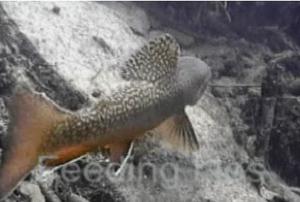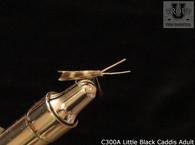
As you know, if a trout sees you, all you will see of him is a flash as he rockets away. My quote for that occurrence is “He is headed for Dixie”. In order to be concealed from the trout you need to understand a little about the trout’s vision. We have reviewed this is greater detail in the Trout University free class #206 What Can Trout See and further in class #406 Color Vision in Trout Eyes.
Generally speaking, trout do not see objects above the water and especially those objects that are far away. For the most part objects about 20 feet way will appear as a blur only. However, what will make them take notice is any movement. Most objects in their environment remain still so movement is a sign of danger often meaning a predator. Therefore, move as little as possible and definitely as slow as possible.
With that said, the other consideration is distance from the trout to where you are standing. For to a simple explanation of the refraction of light, the trout will not see things that are low above the water. Higher objects are far more easily seen. If an object is ten feet above the water and twenty feet away, it is readily seen while an object that is a foot above the water and ten feet away will not likely be seen. The lower you are relative to the surface of the water, the closer you can get without them seeing you. If you climb on or stand on top of a tall boulder within 30 feet, you will have every trout in the stream “Headed for Dixie.” Therefore, remain low in profile and move deliberately.
Under normal water currents, trout will be facing upstream looking for food. Their bodies are aerodynamically designed by God so they can remain in the current without exerting a great deal of energy while watching for food. Aquatic insects will be caught in the current and drift down to the waiting trout. Therefore, it is much easier to get close to a trout if you approach them from a downstream direction and cast from a downstream direction when possible. Obviously, this is not always possible, but should be a preference.
Trout have a much wider peripheral vision than we humans. Their eyes are located on the sides of their heads and they can see all around them except for a 30 degree area directly behind them. Therefore, when they are facing upstream, that 30 degree blind spot will allow you to get closer to them. However approaching from the front or their side without being seen will be almost impossible.
Another consideration is that it is necessary to blend in with the surroundings. For example, contrasting colors such as white, yellow or otherwise bright colors are far more easily seen than colors the blend in with their surroundings. Therefore, the best clothing will be the camo colors that blend in with the season when you are fishing. Subdued colors like pale greens, grays or brown will work if camo clothing is not used. I have seen some expert successful anglers even paint their rods and reels with camo colors.
What about noise and the effects on trout? Well, trout can not hear voices so you can talk with your fishing companion, however, they are sensitive to sound which is actually vibrations, thru their lateral line. If you move a rock on the bottom or throw something into the stream, or even if you stumble along the bank, they will “Head for Dixie”. Therefore walk softly, trying not to disturb things on the bottom of the stream.
Now to summarize all the therefores:
* Move as little as possible and definitely as slow as possible.
* Remain low in profile and move deliberately.
* Approach them from a downstream direction and cast from a downstream direction when possible.
* Take advantage of that 30 degree blind spot will allow you to get closer.
* Wear camo colors that blend in with the season when you are fishing.
* Walk softly, trying not to disturb things on the bottom of the stream.
This is a simplified discussion however the most complete and amazing understanding of trout is available in a series of 3 DVDs by “Ozzie” Ozefovich.
“Trout Vision & Refraction”- See our flies and our world from a trout’s perspective.
“Discovery”- To truly know, trout you must see the world through their eyes.
“Feeding Lies”- Where are they holding what are they eating, how do I use this information?
I highly recommend all three of these amazing in depth DVDs. Order the





